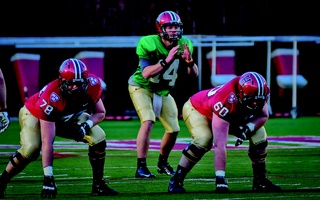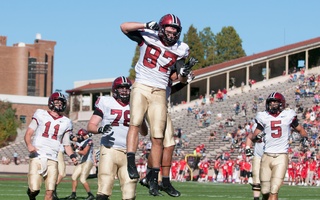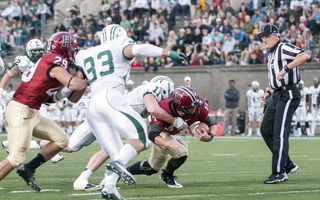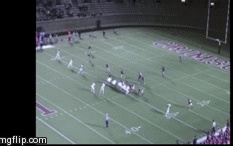
Senior receiver Ricky Zorn, who became a wideout at the end of his freshman season, leads Harvard in catches and receiving yards.
It was fourth down, and the Harvard football team was in trouble. Already trailing 13-0 to Princeton, junior quarterback Conner Hempel dropped back and lofted a deep pass into the end zone. When the ball deflected off a Tigers defender, the Crimson’s drive seemed to be over.
But senior wide receiver Ricky Zorn tracked the football in the air, dove forward at an angle, and reeled it in to complete the 33-yard touchdown pass. Zorn would finish the game with 168 receiving yards.
A week later, junior tight end Tyler Hamblin posted a team-high 56 receiving yards and was a constant target in a 34-0 win over Columbia. Hamblin has registered at least one catch in each of the Crimson’s last six games.
Upon coming to Harvard, Zorn and Hamblin expected to contribute heavily to the Crimson’s success. That’s exactly what they have done—but not exactly how they might have expected.
Zorn and Hamblin both played quarterback in high school. Now, instead of dropping back to pass, the two players are on the other end of the aerial attack. Instead of making plays with their arms, they now do so with their hands.
In a season plagued with injuries, Zorn and Hamblin have become two consistent faces in a rotating Crimson offense. They may not be playing the position that brought them to Harvard in the first place, but their contributions have helped fuel the team to an 8-1 record entering the final game of the year.
TIME FOR A CHANGE
The adjustment is never easy. College football is enough of a step up from the high school level. The thought of learning a new position as well is enough to make even the most assured athlete apprehensive.
“You never shove it down their throat,” Murphy said. “Kids feel their eligibility clock ticking, and they just want to play. In Ricky and Tyler’s case, they’re like, ‘Coach, whatever you say. Whatever’s best for the team.’”
Both players had always possessed the physical qualities to make it as a pass catcher at the collegiate level. In high school in Dallas, Tex., Zorn played football, basketball, baseball, and track and field. He was recruited not only as a quarterback, but also as an athlete.
“[Zorn is] very fast, he’s got great body control, and he’s got great hands,” Murphy said. “So he’s a total package in that regard. But the other one is that he’s a very tough, physical kid. That’s not necessarily a given at the wide receiver position.”
Directing his own high school offense behind center, Hamblin led his squad to two straight state championship games. At 6’4”, Hamblin had the height to toss touchdowns over the heads of defensive linemen. But the potential to out-jump defensive backs for high passes lurked as well.
Hamblin spent his freshman year at Harvard at quarterback. But after the spring season, Murphy called him into his office and proposed making a transition to tight end. Both he and offensive coordinator Joel Lamb believed that making the switch was the best way for Hamblin to get on the field as soon as possible.
“[They] thought I could benefit and the team could benefit from the move,” Hamblin said.
When it comes down to it, a team can only use one quarterback at a time. But different sets ensure that as many as four tight ends get action within a single game, and at least five different wide receivers typically catch passes on a given Saturday.
Read more in Sports
Players Remember '29-29,' 45 Years LaterRecommended Articles
-
 Crimson, White Battle in Spring Game
Crimson, White Battle in Spring Game -
 Football Looks to Rebound Against Dartmouth
Football Looks to Rebound Against Dartmouth -
 Football Beats Dartmouth in Final Minute, 24-21
Football Beats Dartmouth in Final Minute, 24-21 -
 What Your Text Punctuation Really Means
What Your Text Punctuation Really Means -
Football Season RecapIn a season filled with triple-overtime games, nail-biting victories and defeats, and last-second field goals, what was perhaps the most crucial game for the Harvard football team was not even played by the Crimson
-
 Upon Further Review: How Holy Cross Was Beat
Upon Further Review: How Holy Cross Was Beat













